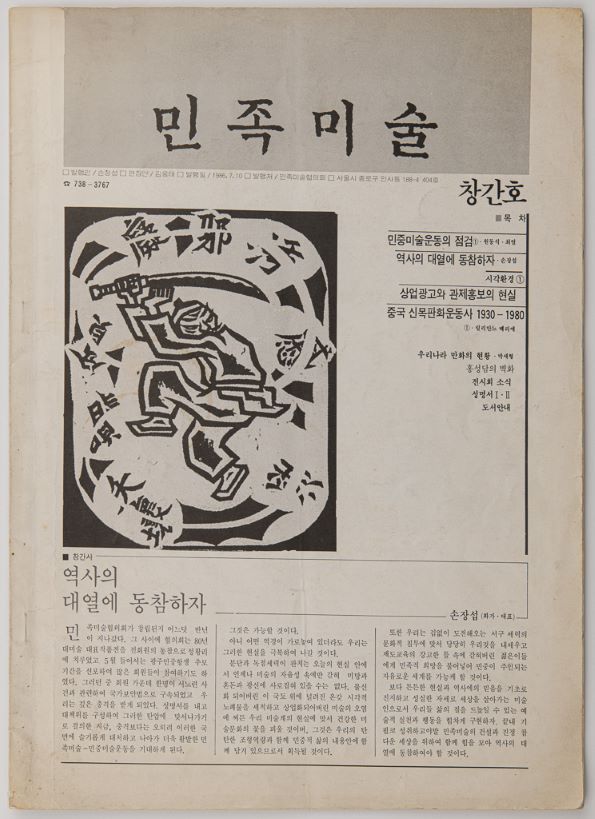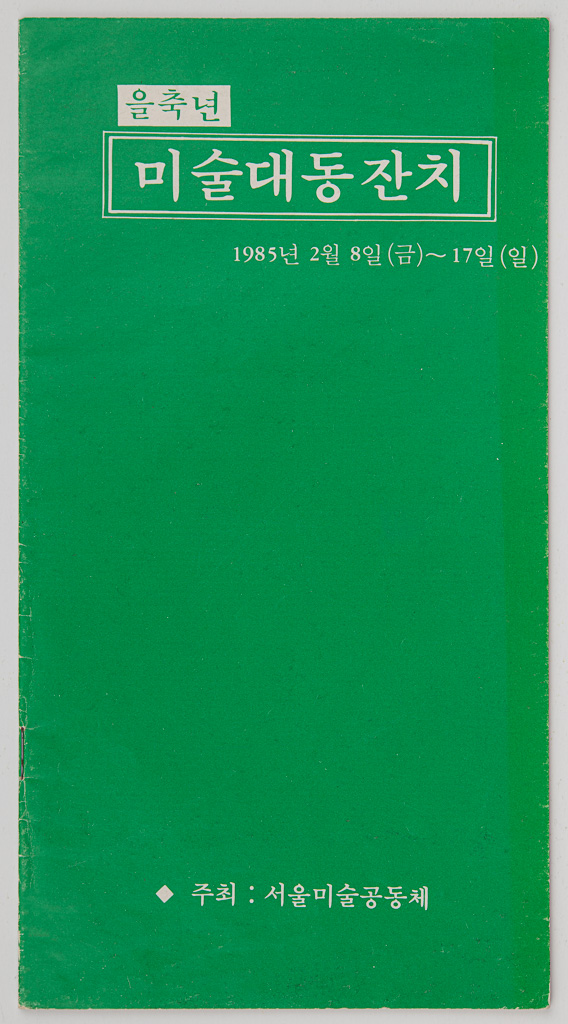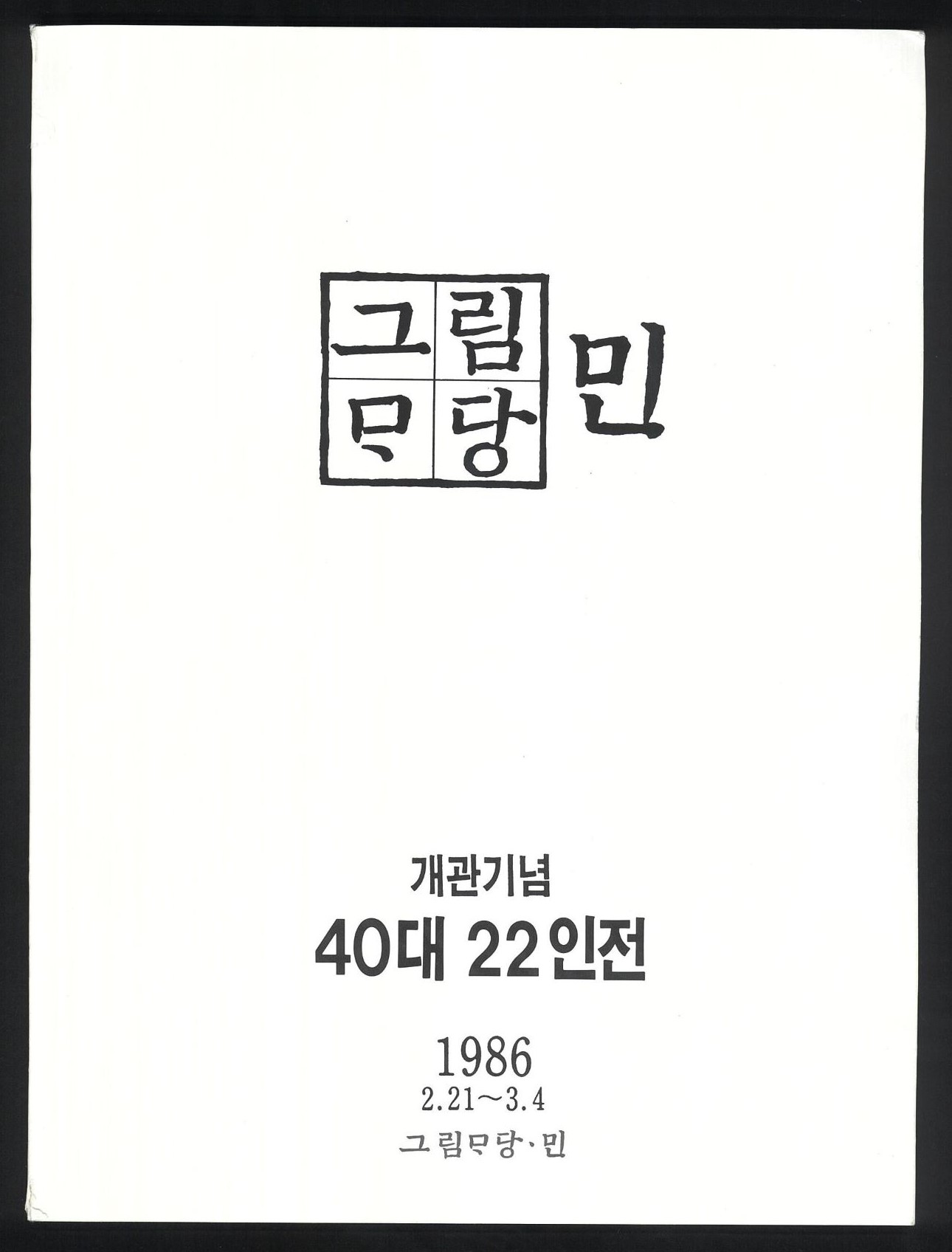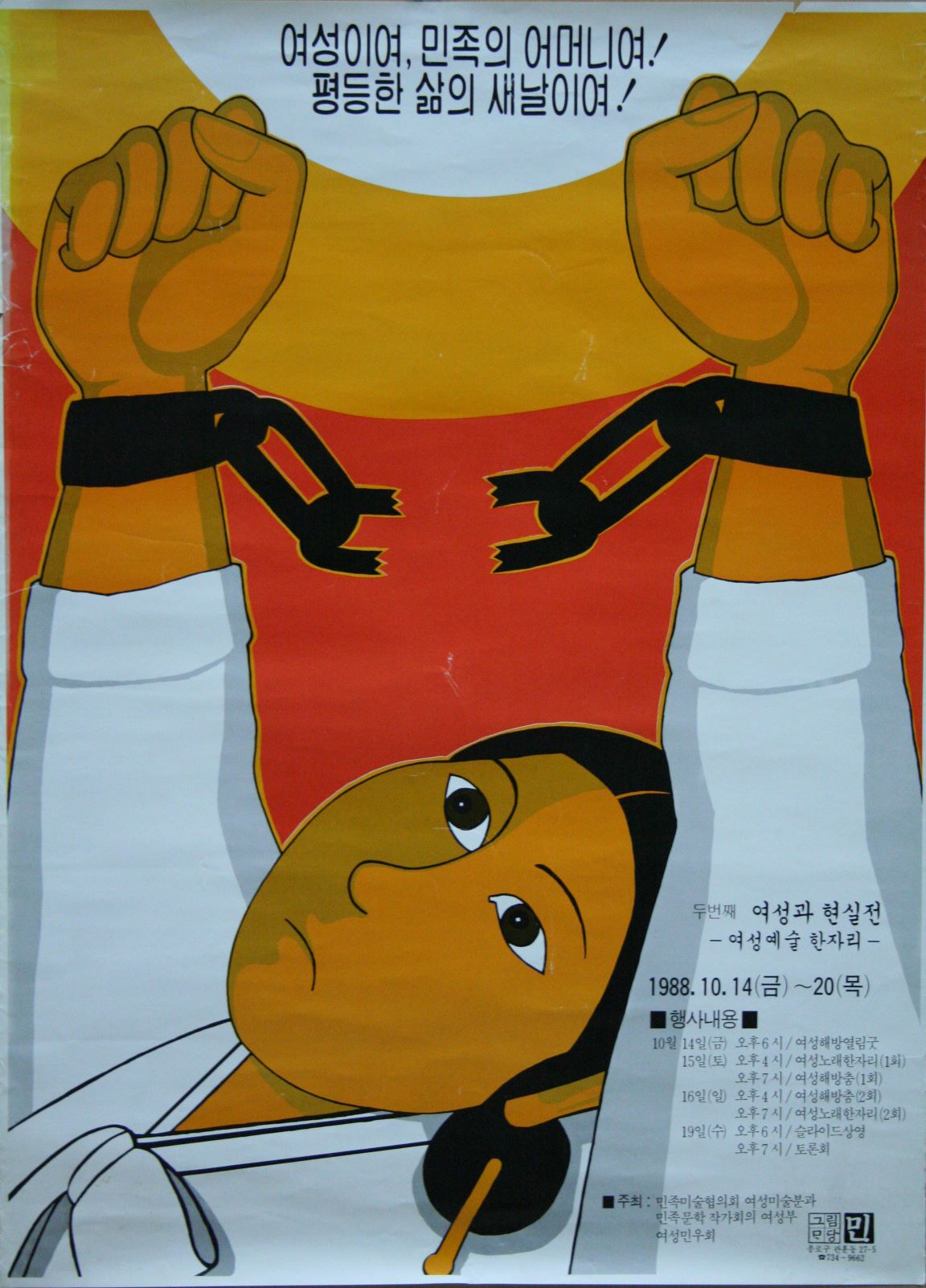
Minjok misul no. 1, MMCA Art Research Center Collection, Gift of Choi Youl
National Art Association
* Source: Multilingual Glossary of Korean Art. Korea Arts Management Service
Related
-

Minjung Art
An artistic movement that came to prominence alongside Korea’s democratization movement in the 1980s. Minjung artists often sought to critically portray the violent repression and corruption of the military dictatorship, to represent the experiences of laborers and farmers, and to achieve social change through art. In contrast to abstraction, which constituted the mainstream of 1970s art in Korea, Minjung Art is notable for the use of representational and figurative forms. One possible point of origin for Minjung Art is Oh Yoon’s work in the Reality Group (Hyeonsil dongin). The group was formed in 1969 by Kim Ji-ha, Oh Yoon, and Lim Se-taek. A variety of Minjung art groups were established, including the Reality and Utterance (Hyunsilgwa bareon) in 1979 by Kim Jungheun, Oh Yoon, Joo Jae-hwan, art critic Sung Wan-kyung, and Choi Min, the Gwangju Freedom Artist Association (Gwangju jayu misulin hyeopuihoe) in 1979 by Hong Sungdam and Choi Youl, the Imsulnyeon (The Year Imsul) in 1982, and the Dureong in 1983. These groups all commonly critiqued Western capitalism. In terms of form, Minjung artists adopted traditional and ethnic folk modes of expression using diverse media such as collage, printmaking, oil painting, and photography. Following the 15 Years of Korean Minjoong Arts: 1980-1994 Exhibition at the National Museum of Modern and Contemporary Art, Minjung Art became an accepted part of Korean art history. Overseas, Minjung Art has also become a recognized term that describes this genre and its unique focus on the political and social history of Korea.
-

Seoul Art Coalition
The Seoul Art Coalition (SAC) was a solidarity community of small groups in the Seoul area that was formed in 1984 and was active until 1987. From October 1 to 3 in 1983, the “Three Days and Three Nights Discussion” was held in Daeseong-ri, Gapyeong, Gyeonggi-do Province. At the time, Ok Bonghwan, Kim Bongjun, Moon Youngtae, Chang Jinyoung, Choi Minhwa, Choi Youl, Hong Seonwung, and Hong Sungdam gathered to discuss the nature, direction, and challenges of an art movement. They decided to promote an art movement based on solidarity. It was agreed that each region would form an “art community” based not on the critical realism of “Reality and Utterance” but on folk realism. The idea was to form art communities in Seoul, Gwangju, Busan, Incheon, Jeju, and other regions and grow them into a national organization. Choi Minhwa immediately discussed the concept of an art coalition with Yoo Yeunbok and Park Jinhwa. Choi was designated as the person in charge of cartoons, Yoo Yeunbok for mural paintings, and Lee Ki-jung for prints. From January 1984, the SAC began hosting open forums to restore and build a healthy art. It compiled materials and printed 200 copies of Hyeondae misul (Contemporary art). In June of the same year, its members participated in Life Portrayed by 105 Artist, and in September they held an inaugural meeting for the “art coalition” and elected Choi Minhwa as the first director of planning. In October, the SAC published a print calendar Poems and Woodcut Calendars (Woorimadang). The SAC was officially launched in February 1985. The small groups that joined the SAC include Silcheon (Geurim dongin Silcheon), Hoengdan, Namu [Mokpan moin namu], Espa, the Committee of Sidaejeongsin(Zeitgeist) [Sidae jeongsin gihoek wiwonhoe], Mural Painting Organization Sipjangsaeng [Byeokhwa giheok sipjangsang], and Uksae. Its purpose was to “creatively develop the rich formal values of visual arts, fight against any factors that restrict free expression, and seek ways for artworks to be committed to the lives of people.” Simultaneously with its launching, the SAC held art fairs for the populace, such as Eulchuknyeon Group Art Festival and the Gangnam Art Market. In April, it published its bulletin Misul gongdongche (Art community). The publication continued until 1986 with a total of five volumes. In May, the SAC created and posted a hanging painting at the May Third Incheon Laborers Conference. In June, the first general assembly was held, and Son Kihwan was elected as the second director of planning. In July, Son Kiwhan, Park Jinhwa, and Park Buldong curated the exhibition Power of the Art by the Twenties but the police arrested the artists and confiscated their works. In February 1986, the Byeonginnyeon Group Art Festival was held at the Arab Art Museum. At the second general assembly in March, Yoo Yeunbok was elected as the third director of planning, and at the third general assembly in 1987, Park Jinhwa was elected as the fourth director of planning. On June 17, 1986, the SAC painted the mural Joy of Unification on the building in front of Sinchon Station, and on July 26, it did the mural Co-Living on the wall of Yoo Yeunbok’s house. These two murals were defaced by the state. Those who created the latter, including Yoo Yeunbok, Kim Jinha, Choi Byungsoo, Hong Hwanggi, and Kim Yongman, were indicted without detention. The SAC organized the exhibition Satire and Humor in August and the exhibition Art and Politics at Great Transition, in November 1987. In January 1988, the SAC members discussed its dissolution at a restaurant in Insa-dong and then disbanded. The SAC is the first collective of small groups that was formed after the agreement on turning the national organizations of Minjung art movement into art communities was made. They accomplished significant achievements in the popular art movement, mural movement, and art discourse.
-

Korean Federation of Cultural Organizations
A right-wing association founded on Feburary 12th, 1947, to challenge leftist groups, such as the Central Committee for the Construction of Korean Culture [Joseon munhwa geonseol jungang hyeopuihoe], the Korean Federation of Cultural Organizations [Joseon munhwa danche chong yeonmaeng], and thek Korean Young Literati Association [Joseon cheongnyeon munhakga hyeophoe]. Its nickname was ‘Munchong.’ The Organization opposed trusteeship, supported national culture, and was anti-communist. Participating groups included the Korean Art Association [Joseon misul hyeophoe], the Association of Joseon Writers [Jeon joseon munpilga hyeophoe], Theater Art Association, Joseon Film and Screenplay Writer Association, Joseon Young Literati Association, Dangu Art Academy [Dangu misulwon], Foreign Literature Study Group, Korea-China Cultural Association, Joseon Documentary Photography Cultural History, Chungang Cultural Association, Joseon Educational Art Association, Goryeo Music Association, the National Wind-instrument Music Association, The Center for Historical Truth and Justice, the Joseon Calligraphy Association, the Biology Society, Danshimhoe, the Joseon Education Society, the Joseon Sports Society, the Construction Technology Group, the Korean Commercial Art Association [Joseon sangeop misul hyeophoe], the Joseon Art Photography Association [Joseon sajin yesul yeonguhoe], the International Culture Association, the Joseon Photography Association, and the Joseon Astronomy Society. The first president was Ko Huidong, vice-presidents were Park Jong-hwa and Chae Dong-sun, and the manager was Lee Heon-goo. Their magazine Minjok Munhwa (National Culture) was published in 1949. The group was actively involved in many activities, (such as constructing Munchonggugukdae) until it was disbanded due to the May 16 military coup in 1961.
Find More
-

Min Art Gallery
A notable exhibition space for minjung art that was established in 1986 by the National Art Association. The gallery formed during heightened political tensions after the military dictatorship’s censure of the The Year 1985, Power of the Art by the Twenties exhibition, which was held in 1985. The gallery hosted the Bangomunjeon, a direct critique of political reality, and it also held feminist art exhibitions such as the Women and Reality exhibitions from 1987 to 1993, which were organized by the Women’s Art Research Society [Yeoseong misul yeonguhoe]. In addition to art exhibitions, the gallery hosted film festivals, seminars, and educational programs as well as serving as a venue for discourse on the future direction of minjung art. After minjung art lost momentum in the beginning of the 1990s, financial difficulties caused the gallery to close in 1994.
-

Women and Reality
Women and Reality was an annual exhibition staged from 1987 to 1994 and organized by the Women’s Art Division of the National Art Association (Minjok misul hyeopuihoe). Kim Insoon, Kim Djin-suk and Yun Suknam, founding members of the National Art Association in 1995, were aware of the patriarchal tendency within the Minjung art community, and the general indifference to gender issues. They founded the Women’s Art Division within the Korean People’s Artists Association in December, 1986, with other women artists, such as Koo Seonhwe, Kim Minhee, Shin Gayoung, Lee Kyungmi, Jung Jungyeob, Choi Kyungsook, and Moon Saem. These artists actively engaged with Women's Art [yeoseong misul] and organized an annual exhibition, titled ‘Women and Reality’, from 1987 to 1994. They planned exhibition tours around Korea. They renamed the Women’s Art Division, the Women’s Art Research Society [Yeoseong misul yeonguhoe] in 1988 to highlight its aim to continue to explore gender issues through art.
-
![Women's art [yeoseong misul]](/admin/uploadGoods/87afde62-e10f-4272-96f4-4d55236089bb.jpg)
Women's art [yeoseong misul]
Yeoseong misul, or "women's art," is a term that distinguishes artworks that are produced by women from those of men. It is also an umbrella term for "yeoryu misul" and feminist art that emerged in the history of Korean art in the twentieth century. In modern Korea, works of art created by women were referred to as "yeoryu misul" to distinguish between the genders, implying that women's work was inferior to men's. Until the 1970s, the term yeoryu misul was used to separate and disparage women within the male-dominated mainstream art world, but it also came to mean art by women artists that incorporated women's experiences and perspectives. In the 1980s, the Women's Art Research Society [Yeoseong misul yeonguhoe], organized within the Minjung art movement, began to use the term “yeoseong misul” anew. The women artists rejected the term “yeoryu misul,” which disparaged women's work, and wanted to resist the Western ideas of feminist art, which were not in line with Korean conditions. They devised the term yeoseong misul as an alternative. Oh Hyejoo and Min Hyesook defined yeoseong misul as distinct from yeoryu misul, and the former was not merely an expression of femininity but rather art for the liberation of women oppressed by gender and class. In the 1990s, criticism and discussion of the concept of yeoseong misul expanded. Park Shineui agreed with the view that women's issues are issues of all human beings, however, she argued that it is necessary to move away from the rigid thinking within the Minjung art movement that equates yeoseong misul with the liberation movement of working-class women. She also urged that Minjung art should move beyond a limited form of realism and develop diverse mediums and also criticize patriarchal issues within the art world. Kim Hong-hee distinguished between the yeoseong misul born out of the context of the 1980s Minjung art movement and the yeoseong misul that emerged in the context of postmodernism in the early 1990s. Later generations, however, criticized the error of evaluating Korean yeoseong misul based on 1970s feminist art in the United States. They argued that Korean yeoseong misul is a manifestation of feminism itself, which opposed the male-dominated culture, and asserted that it is an independent feminist art that cannot be confined to concepts like yeoseong Minjung misul or Minjung art.






